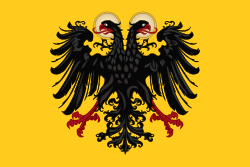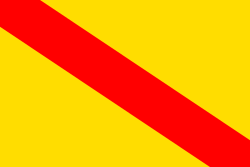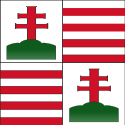Rakousko-turecká válka (1663–1664)
| Čtvrtá rakousko-turecká válka | |||
|---|---|---|---|
| konflikt: Osmansko-habsburské války | |||
 zobrazení bitvy u Szentgotthárdu | |||
| Trvání | 17. duben 1663 – 10. srpen 1664 | ||
| Místo | Uhersko | ||
| Výsledek | Vasvárský mír | ||
| Strany | |||
| |||
| Velitelé | |||
| |||
| Síla | |||
| Některá data mohou pocházet z datové položky. | |||
Čtvrtá rakousko-turecká válka, někdy označovaná také první turecká válka[1], bylo vojenské střetnutí mezi habsburským soustátím a Osmanskou říší vedená v letech 1663 až 1664.
Válku Habsburkům vyhlásil turecký sultán Mehmed IV. v dubnu roku 1663. Jeho vojska překročila Dunaj a nedaleko Štúrova porazila narychlo svolanou zemskou hotovost. Poté se vydala k pevnosti Nové Zámky, kterou oblehla. Pevnost padla po více než měsíčním obléhání v září 1663. K rozhodujícímu střetnutí konfliktu došlo 1. srpna 1664 v bitvě u Mogersdorfu či Szentgotthárdu, kde Turci utrpěli těžkou porážku a museli se stáhnout. Přestože měl Leopold I. strategickou výhodu, kvůli nedostatku financí na vydržování armády podepsal 10. srpna téhož roku s Osmany pro něj nevýhodný mír ve Vasváru, ve kterém uznal tureckou kontrolu nad Novými Zámky a Sedmihradskem.
Následkem podepsání nevýhodného míru vypuklo roku 1664 v Uhersku Wesselényiho spiknutí.
Literatura
- RYCHLÍK, Jan; PENČEV, Vladimir. Od minulosti k dnešku. Dějiny českých zemí. Praha: Vyšehrad, 2013. ISBN 978-80-7429-387-0. s. 237–238
Externí odkazy
 Obrázky, zvuky či videa k tématu Rakousko-turecká válka na Wikimedia Commons
Obrázky, zvuky či videa k tématu Rakousko-turecká válka na Wikimedia Commons
Reference
- ↑ Rychlík, Penčev (2013) s. 237
Média použitá na této stránce
Autor: David Liuzzo, eagle by N3MO, Licence: CC BY-SA 3.0
Banner of the Holy Roman Empire, double headed eagle with halos (1400-1806)
Autor: David Liuzzo, eagle by N3MO (re-uploaded by Dragovit), Licence: CC BY-SA 3.0
Banner of the Holy Roman Empire, double headed eagle without haloes (1400-1806)
Autor: Sodacan, Licence: CC BY-SA 3.0
Královská standarda francouzského krále (používaný jako státní vlajka Francouzským královstvím v období absolutní monarchie). Používaná byla v letech 1638 až 1790.
Autor: BlinxTheKitty, Licence: CC BY-SA 4.0
Possible flag or banner of the Ottoman Empire (or Ottoman army) according to Hieronymus (aka Jérôme) Bosch (crwflags.com), the painter lived in the Middle Ages (c. 1450–1516) in Brabant and some of his paintings show Ottoman flags. These are generally red with a white crescent. It was the end of the XVth century, when the Ottomans had just conquered Constantinople and thus ended the Byzantine Empire, that was a shock for the Christian world.
Autor: Dahn, Licence: CC BY-SA 4.0
Flag of Moldavia as described by Alexander Gwagnin (Guagnini), circa 1574, quoted in Petre Ș. Năsturel, "Steagul 'de luptă' al lui Ștefan cel Mare: prapur bisericesc ori poală de icoană?". Analele Putnei Vol. I, Issue 1, 2005, pp. 48–49. Design of the aurochs is based on Moldavian coat of arms found in Szymon Okolski's Orbis Polonus, circa 1641 (and reproduced in Dan Cernovodeanu, Știința și arta heraldică în România, p. 259. Bucharest: Editura științifică și enciclopedică, 1977).
Banner of the Arms of Baden in 3:2 proportion.
Flag of Wallachia (cca. 1593 - 1611). This model was composed by Romanian heraldist Dan Cernovodeanu, after two (almost) identical contemporary descriptions of the flag of en:Michael the Brave (1593 - 1601) and en:Radu Şerban (1602 - 1611):
The flag is from white damascus on which is depicted a raven [sic!] with a red double cross and a red star in his berk, standing over a green juniper. (Ciro Spontoni, Historia della Transilvania, Venice, 1638)
The bird is a combination between aquila and raven, as it appears on contemporary seals.Autor: Samhanin, Licence: CC BY 3.0
Flag of Croatia (Early 16th century–1526) per source, which is historically innacurate as such a flag or coat of arms was used only since 1527 when the Croatian nobility elected the Habsburg dynasty.
Autor: Durero, Licence: CC BY-SA 4.0
Ensign of Brandenburg Navy circa 1684. Drawing based on Die kurbrandenburgische Flotte (1684).
The Battle of Saint Gotthard (German tidings)
This is the Coat of Arms of the dynasty Hohenstaufen. It was used from ~1216.
Autor: Tento vektorový obrázek byl vytvořen programem Inkscape ., Licence: CC BY-SA 4.0
Flag of the Electorate of Bavaria
State Flag of the Savoyard States (late 16th - late 18th century).
Rectangular version of the Hungarian flag at the battle of Baia (1467) according to the Chronica Hungarorum.
Autor: Dahn, Licence: CC BY 4.0
Banner of Gabriel Bethlen, Prince of Transylvania, in 1615. Features Bethlen's arms alongside Transylvania's, within a red field with "tongues of fire". Based on several reconstructions, including that provided by the Hungarian Canadian Cultural Center, MaghiaRomânia, and Parókia Portál.
















